STEEMIT CRYPTO ACADEMY | S4WEEK7 -THE GOVERNANCE OF THE TRON ECOSYSTEM
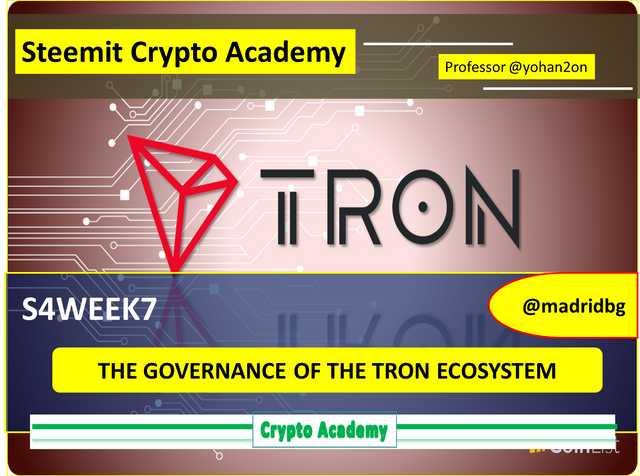
Authored by @madridbg, via Power Point 2010, using public domain images. cointext
Greetings and welcome dear readers and lovers of the world of decentralized finance, this installment is aimed to comply with the task assigned by Professor @yohan2on, in week 7 and of the current season 4 driven from the #SteemitCryptoAcademy community.
The same is oriented in the understanding of the TRON blockchain, as well as the functioning of election of super-representatives and governance agents in this blockchain, therefore we will make a conceptual and practical approach that allows us to fully comply with this assignment.

CONCEPTUAL AND PRACTICAL APPROACH ASSOCIATED WITH TRON GOVERNANCE.

As is well known in my publications, this section is dedicated to the approach of each approach requested by the teacher, for this, we focus on the conceptual aspects and its practical foundation that allows a comprehensive approach to the subject that concerns us.
1. Who are the Super Representatives, SR Partners and SR Candidates? (TRON Ecosystem Governance).

Before going into the matter associated with the levels of governance behind the TRON blockchain, it is necessary to remember that in previous publications we mentioned the functioning of this ecosystem, where we managed to establish that it is an easy access platform that allows its users to have interaction to different applications, associated with video games, communication, audiovisual material, among others from the same platform.
The same is based on a consensus mechanism that generates security, speed and dynamism to this blockchain, hence it is the widest and most used by users, not to mention the low commissions and speed in their transactions, in addition to allowing the development of smart contracts, DApp tokens and the applications associated with these.
Based on the above, it is necessary to make clear that the governance currency of this blockchain is Tronix (TRX) and from it the governance levels are established.
In this sense, it is valid to ask How are governance levels established in the TRON ecosystem, to answer this question it is necessary to know how the consensus mechanism works, which is based on the thin proof of stake, referring to algorithm protocols developed by Daniel Larimer, the same is able to offer tolerance to Byzantine failures in the system, which generates a blockchain with high levels of security.

Consensus mechanisms make the Tron network more dynamic. Author: Gerald
Methodologically, TRON's governance systems are based on Delegated Proof of Stake (DPoS), which works by means of Staking and generates fundamental blocks based on the election of representatives who categorize them as follows:
1. Candidates to super representatives, this selection is limited to 147 individual nodes according to the degree of participation in the TRON network, from the total of candidates, from 1 to 27 are chosen to serve as super representatives, from 28 to 128, as super partners and from 129 to 147, will be on standby once the cycle of 6 hours, which is the temporality between one election and the other, has finished.
2. Super representatives (SR), this category comprises a total of 27, the same have the privileges of block production, as well as to verify the transactions that are made, through these protocols the network gains scalability and the processes are more efficient and faster.
Now, these representatives are elected by voting, where all users who have in their wallets power in TRX can participate, that is, who have staked TRX tokens and the votes are surrounding and are executed every 6 hours, hence the dynamism of the network.
3. Super partners (SR), in this category enter those representatives who were in the position between 28 and 128, the same has as a function determined to perform an accompaniment in the work of the super representatives, so they can assume functions such as verifying that the work and transactions are executed in the best way, like the previous ones, the elections are renewed every 6 hours, which allows to maintain the security of the network.
Consequently, it is to be expected that the system bets on a reduced group of nodes which is chosen by elections according to the TRX voting power bet. With respect to block generation this is carried out every 3 seconds, a surprising speed for the network and depending on the amount of blocks generated, are the returns obtained by both super representatives and super partners.
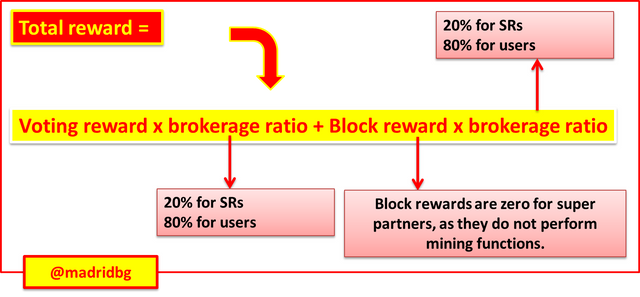
As can be seen in the image above, we have detailed the equation for the reward calculation of those chosen to fulfill the role of super rep or super partner, the only variation between the one and the other is the percentage of mining that is not associated with the super partners as they do not fulfill this role.
Next, we will show in real time the distribution of votes in the election of the representatives as well as other characteristics of the network.
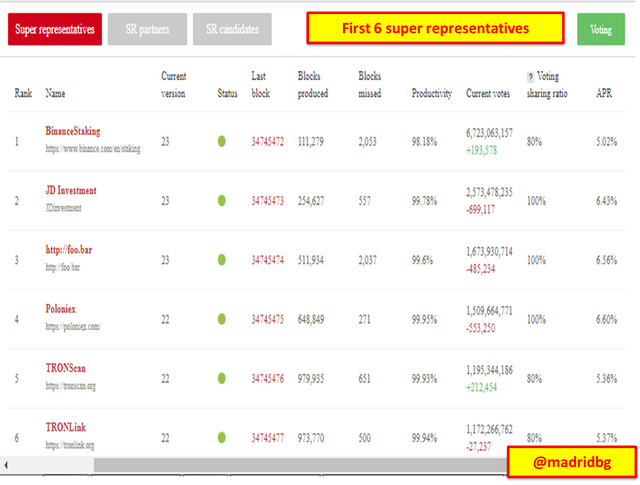
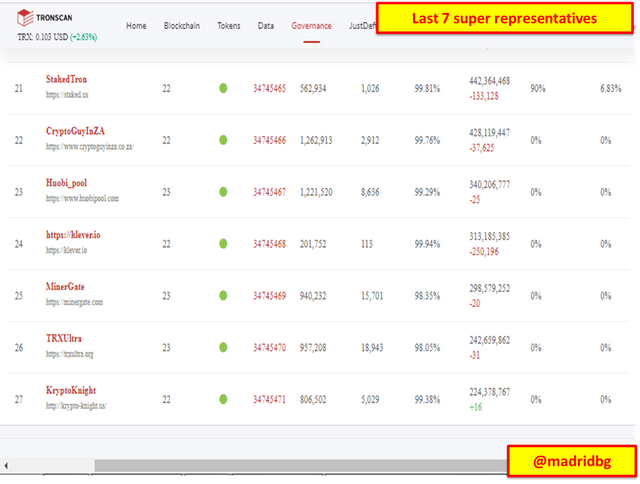
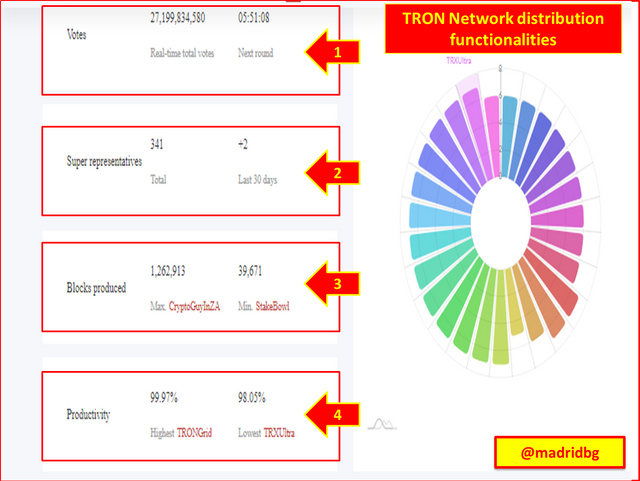
2. What is the difference between DPoS and PoS consensus mechanisms?.

This section of the subject is necessary to be as understandable as possible for those readers and users who make life in the blockchain. In this sense, choosing the right protocol generates in the blockchain, speed, transparency, scalability and security in transactions.
Based on the above, consensus protocols allow shared records to be developed in the most reliable way possible, without intermediaries and starting from decentralized mechanisms, so it is to be expected that the consensus protocol guarantees the creation of blocks without failures or affections by malicious attacks that attempt illegitimate changes in the record of the chain.
Based on the above, let's establish accurate differences that allow us to evaluate the functions of the DPoS consensus mechanism in relation to the PoS, which we will break down below:
About the POS consensus mechanism
Before explaining this protocol I would like to quickly mention the workings of the POW protocol, it was introduced into the Bitcoin network by the unknown Satoshi Nakamoto, it spread and was adopted by other crypto-assets.
It is based on the fact, to use the computational capacity of miners to solve cryptographic puzzles in exchange for substantial fractions of the mined BTC, however, this protocol is currently the most used has some disadvantages, among which stand out, the excessive use of electrical energy and vulnerability in the attack of 51%.
Consequently, as a way to correct the flaws of the POW protocol, the creation of the PoS (Proof-of-Stake) protocol, designed for public chains, has as its objectives to stop using money in computer equipment and instead invest that money in buying cryptoassets that serve as the equivalent of the computing capacity generated in POW.
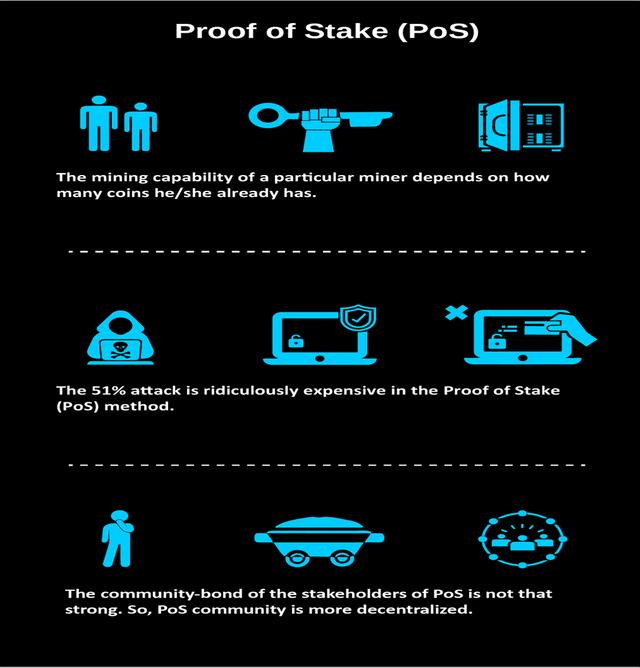
PoS stake consensus mechanism. Author: prsarahevans
Therefore, the previous energetic problem is no longer one of the vulnerabilities, methodologically the algorithm makes a random selection of the validator that will be responsible for adding the next block, from there, we can assume that this algorithm works as a kind of lottery, where the more tickets or assets we have the higher the probability of winning.
In other words, in proof of stake bockchain there is no mining and the validation of new blocks depends on the amount of coins that are stacked and the more coins you have the higher the chance of being chosen as block validator.
Under this concept the chain presents:
* Increased computational speed, which translates into faster and more efficient transactions.
* Energy efficiency, where power consumption is lower.
* Less hardware power, as the system does not need a traditional mining process to execute the same functions.
Among some weaknesses of the process, we can mention that the concentration of resources will focus on the most economically wealthy, since the probabilities of these increase considerably due to the capital invested.
About the DPoS thin consensus mechanism:
From my point of view DPoS (Delegated Proof-of-Stake), is a variant of the protocol studied above, however, it is based on the fact that coin holders have the ability to choose their delegators, through transparent and decentralized processes.
At this point, the tokens are responsible for adding the new block, so the probability of fulfilling the role of token, is through votes that users take to assume who will be responsible for the new block generated.
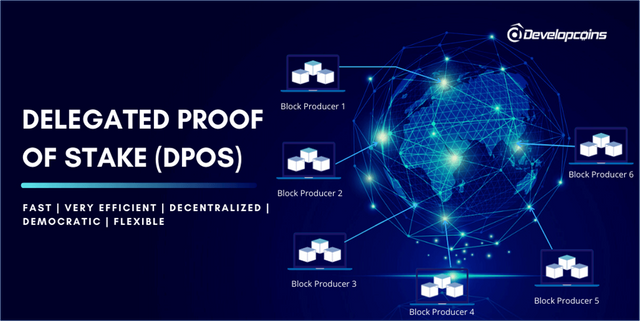
DPoS delegated consensus mechanism, algorithm used in the TRON network. Author:developcoins
Therefore, through this protocol, it is expected that there will be a greater diversification of wealth among users, which would generate the following advantages:
1. Security in the election of the slim, since the voting process is generated in real time and in specific time periods that vary between 4 to 6 hours, according to the blockchain.
2. Better distribution of rewards, since these do not depend exclusively on the monetary capacity of the user, so they tend to form more decentralized processes.
Among the disadvantages that this protocol may present, is the 51% attack, since it can generate communities of voters who keep their members or delegators as witnesses, likewise, this can trigger centralized processes led by a specific group of people.
As an integration of knowledge, we can establish that PoS and DPoS are similar in the sense of participation, although the democratic participation system of the DPoS protocol gives an added value to it, since the block producers are elected by voting and not by the amount of coins owned. In this sense, honesty comes to the fore as a delegate who fails to perform his duties is immediately excluded.
In terms of operations and transactions, DPoS is much faster and scalable than PoS, in the case of the TRON Blockchain it is based on the use of the DPoS protocol which is nothing more than an adaptation of the POS protocol.
3. Write a step-by-step tutorial showing how to bet / freeze TRX and vote for SR.

As we can see in the process application, there are three scenarios that we must comply with, which we will break down below:
On how to bet freeze TRX and vote for witnesses:
Throughout this writing we have mentioned that through the DPOS protocol, which is the one used by the TRON network, we must have TRX to be able to operate and fulfill the functions of voting, betting and freezing TRX.
At this point, the first thing we must do is go to the Tronscan page (https://tronscan.org/#/), where we must connect our wallet and start section on the platform.
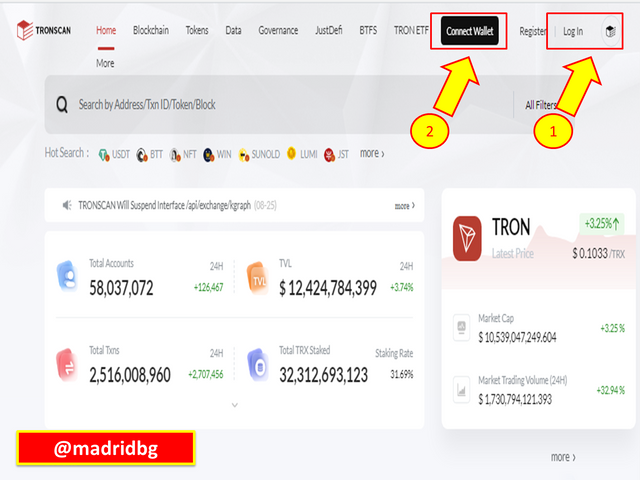
At this point, it will not ask for the selection of the wallet that we have available, in the staff I use Tronlink and we give connect and it will make us a call to our wallet, in the following image we can observe the detail of the established connection.
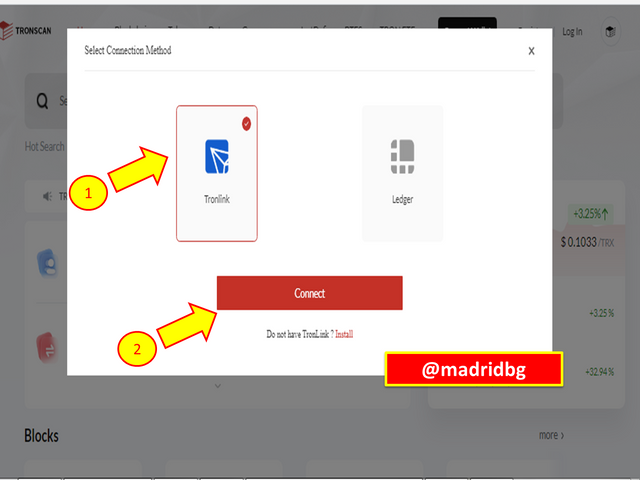
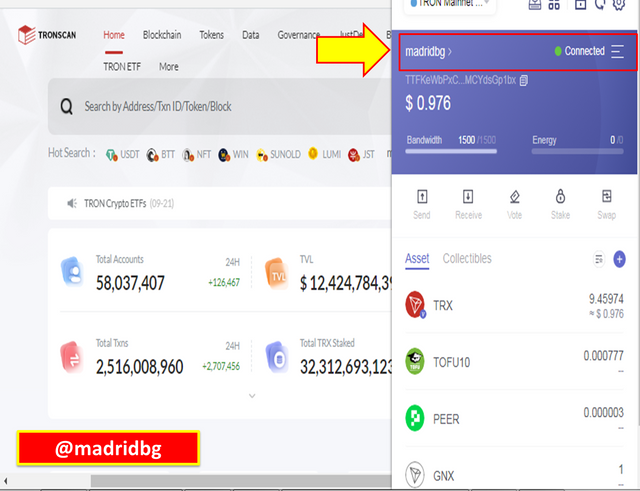
Back to the tronscan home page, we can see that we have already started section and our wallet is connected, continuing we must go to the governance section (pattern 2) and choose option 2 which refers to voting (pattern 3) and then we must go to the voting section (pattern 4).
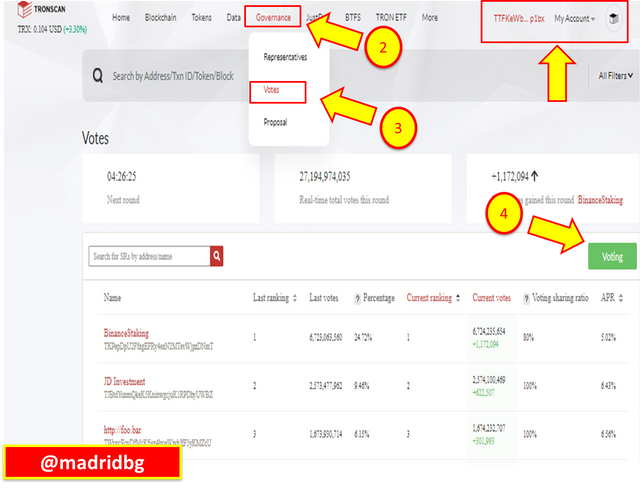
When selecting the voting section, a drop-down panel will open, as shown in the following image, at this point we do not have TRX bets, so we must select the obtain section (pattern 2).
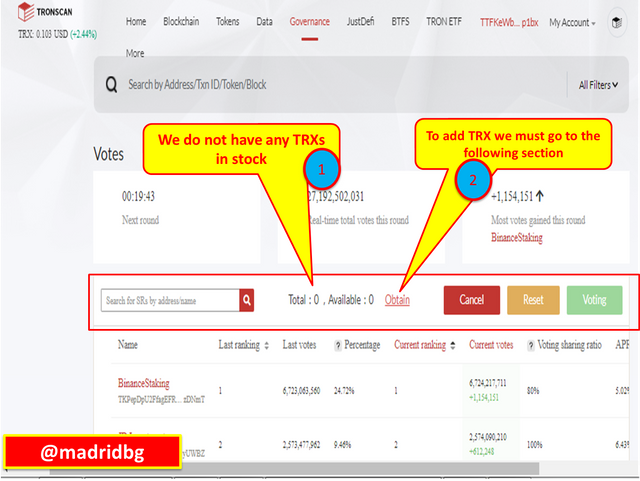
To obtain the resources and power of TRX we must select the amount we are willing to bet and this bet must be confirmed for a minimum of 72 hours. In this particular case, I have decided to bet 9 TRX which is equivalent to 9 votes that I can provide, since it was the amount I had available at the time of preparing the publication.
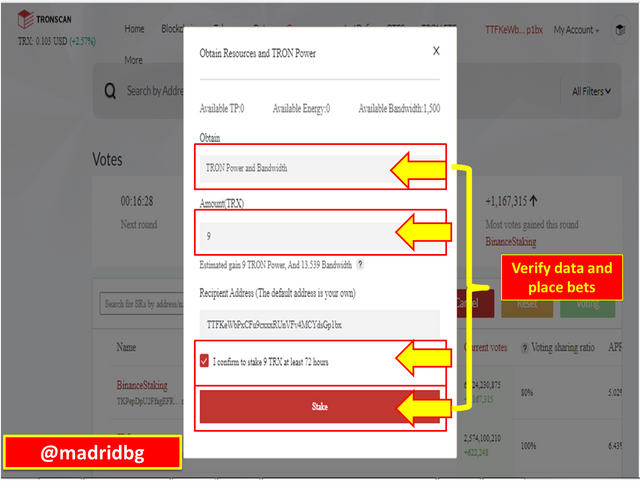
Once wagered we must confirm the operation through our Tronlink Wallet and wait for the confirmation of successful transaction of the wagered tokens.
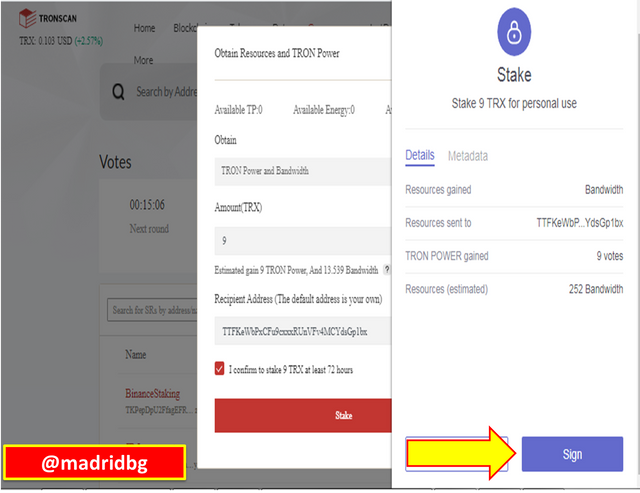
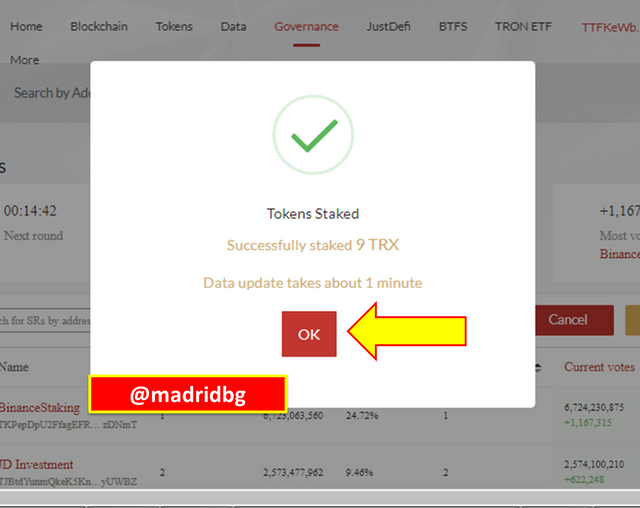
Up to this point we have frozen and staked our resources and we now have the ability to cast votes on the TRON blockchain, as I mentioned above I staked 9 TRX which equals 9 votes I can cast, to generate the votes let's follow the sequence.
We must return to the TronScan page in the voting section and it will show us the amount of votes we can process, we choose the super-representative, as well as the amount of votes we want to apply. In particular I have decided to vote with the maximum vote provided by BinanceStakin, who provides an annual APR of 5.06%.
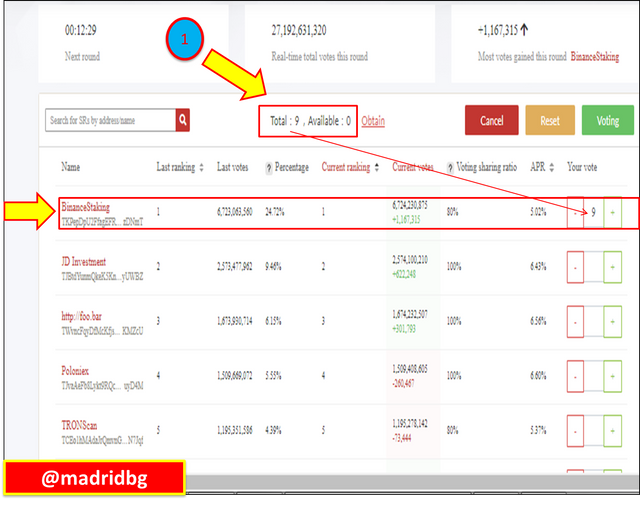
For the transaction to be approved, we must confirm through our wallet and wait for the confirmation message and successful transaction.
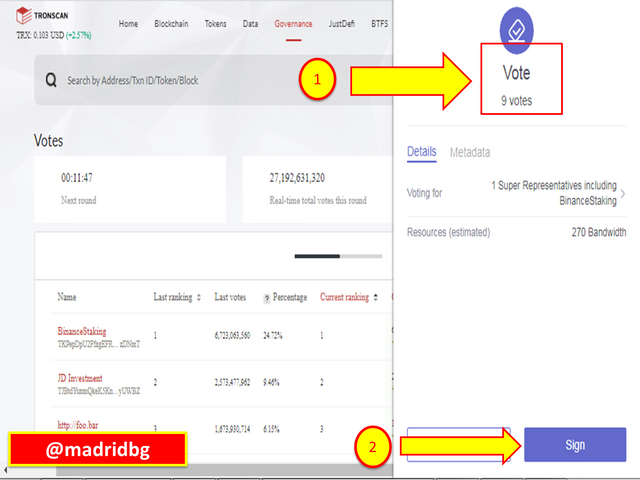
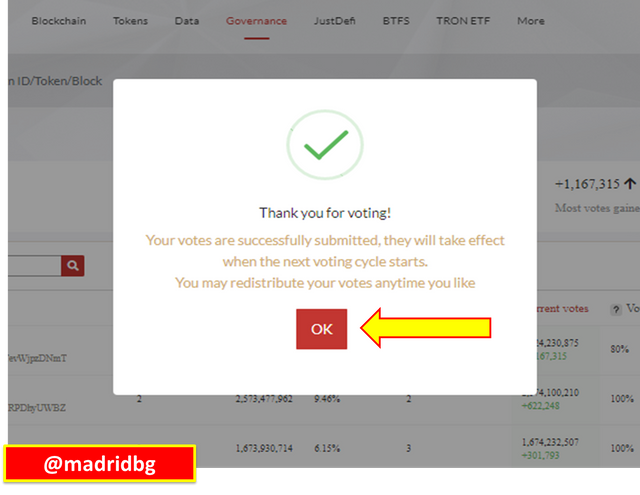
As we can see in the following image, we have frozen parts of our resources through staking and we have acquired voting power that has allowed us to vote for some of the representatives and aspiring super representatives.
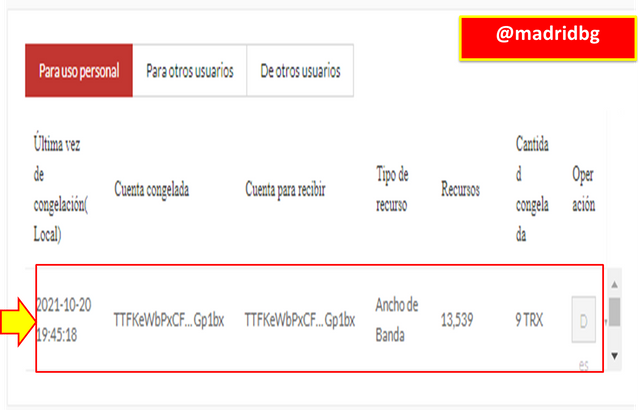

FINAL CONSIDERATIONS

Undoubtedly, the TRON ecosystem provides us with a diversity of scenarios that allow us to capitalize and take advantage of our resources by using delegated governance through the DPOS algorithm, the distribution of resources is more dynamic and equitable, which allows for greater trust among users, as well as greater efficiency and scalability in the network.
Tron has become a diverse ecosystem and highly demanded by the user society that make life in crypto markets, hence the relevance of the research requested by Professor @yohan2on as it allows us to expand our knowledge in this regard.
In this regard, I extend my thanks to the Professor and the #SteemitCryptoAcademy community for the valuable training they provide us every week.

BIBLIOGRAPHIC MATERIAL CONSULTED

[1] Academy.binance. Delegated Proof of Stake Explicada. Article: Online Access
[2] Academy.bit2me. What is TRON (TRX)?. Article: Online Access
[3] GUSTAVO LOPEZ. POW and DPOS: characteristics and differences. Article: Online Access

OF INTEREST


#cryptoacademy #yohan2on-s4week7 #venezuela #steemexclusive #blockchain #tron #steemit #steemitcryptoacademy
Hi @madridbg
Thanks for participating in the Steemit Crypto Academy
Feedback
Total| 9/10
This is good work. Thanks for taking the time to research as you learn about the Governance of the Tron ecosystem.
Greetings dear Professor @yohan2on thank you for the assessment you make on my publication and we will seek to continue improving my performance.
I would like to ask about #club5050, I am still not clear on how this works. I understand that we seek to generate a better dynamic between supply and demand of steem, now I am not clear what I should do to contribute and contribute to the club, I would appreciate it if you could guide me.